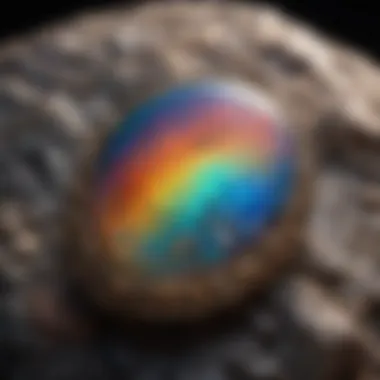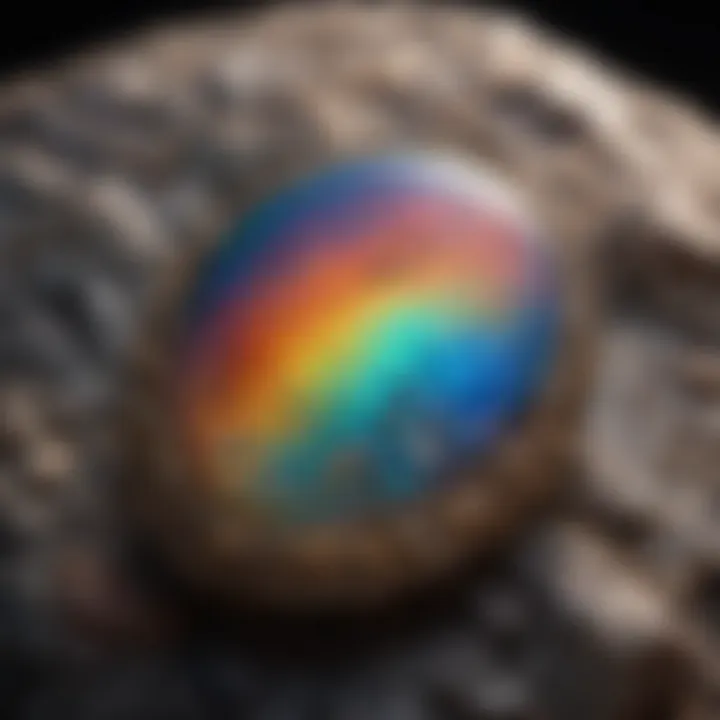Understanding Opal-Like Stones: Characteristics & Significance


Intro
Opal-like stones have captivated the imagination of many, offering a unique intersection of beauty, rarity, and scientific interest. Their vibrant colors and intriguing patterns create an allure that has made them sought after by collectors and enthusiasts. In this exploration, we will delve into their history, origins, classification, and much more. By examining the intersection of geology and culture, we aim to provide a comprehensive understanding of these fascinating geological specimens.
History and Origins
Overview of Collectibles, Rocks, and Fossils
Throughout human history, gemstones and rocks have held significant places in cultures around the world. Opal-like stones, known for their mesmerizing patterns and hues, are no exception. They have been valued not only for their aesthetic qualities but also for their believed mystical properties. Collectors appreciate these stones for their uniqueness and the stories they tell about the Earth's geological past.
Historical Significance and Cultural Impact
The fascination with opal-like stones can be traced back thousands of years. Ancient civilizations revered these stones, attributing various meanings and spiritual significances to them. For example, Romans believed opals to be symbols of hope and purity. In more recent times, the rise of opal in Victorian jewelry marked its status as a desirable gemstone among the elite.
Moreover, opal-like stones are often embedded in various cultural narratives. Indigenous peoples of Australia, for example, regard certain opal deposits as sacred, intertwining the stones with their ancestral lore and beliefs. This cultural richness adds layers to their appeal as collector items and showcases humanity's long-standing relationship with nature.
Identification and Classification
Guide to Identifying Rocks and Fossils
Identifying opal-like stones requires a keen eye and understanding of their distinct characteristics. Here are some key points to consider:
- Color Play: Opal-like stones exhibit a play-of-color effect, where different colors appear based on the viewing angle.
- Transparency: These stones can range from opaque to clear. This feature often impacts their value.
- Inclusions: Natural inclusions can provide clues about a stone's origin and authenticity. Watch for bubbles, minerals, or other distinctive markers.
Common Types and Variations
Opal-like stones come in various forms and types. Some notable varieties include:
- Precious Opal: Displays a vibrant play of color.
- Common Opal: Lacks the play-of-color but may have attractive patterns.
- Fire Opal: Characterized by its bright orange or red hues.
- Boulder Opal: Contains a matrix of host rock, often adding unique patterns and colors.
Each of these varieties presents distinct attributes that appeal to different types of collectors, enhancing the overall diversity in the field of opal-like stones. Understanding these differences is crucial for collectors aiming to identify and assess the value of potential acquisitions.
"The appreciation of opal-like stones is not merely a pursuit of beauty but a deeper engagement with geological and cultural narratives."
In summary, the history, identification, and classification of opal-like stones provide a solid foundation for any collector or enthusiast. As such stones continue to intrigue, their exploration enriches our understanding of both geology and human culture.
Prologue to Opal-Like Stones
Opal-like stones have captivated collectors and geologists alike for centuries. Their unique characteristics and intriguing formations present numerous opportunities for study and appreciation. This section aims to elucidate the significance of opal-like stones, guiding the reader through their definition and historical relevance. Understanding these aspects helps to appreciate the stones' value in both a scientific and cultural context.
Definition and Overview
Opal-like stones refer primarily to a category of minerals that exhibit opalescence, a feature marked by a play of colors under varying light conditions. The term includes true opals as well as other minerals that mimic similar optical phenomena. For rock and fossil collectors, identifying these stones demands a nuanced understanding of their physical properties, such as chemical composition and structure.
The chemical structure of opal-like stones comprises silicon dioxide and other elements that contribute to their distinctive colors and patterns. Unlike many gemstones, opals are non-crystalline, having an amorphous structure shaped by unique conditions during their formation. This amorphous state results in a variety of visual effects, making each stone distinct.
Historical Context
The history of opal-like stones is rich and varied, stretching back to ancient times. The earliest references to opals can be traced to civilizations like the Romans and Greeks, who revered these stones for their beauty and mystique. They often associated opals with purity and hope.
During the Middle Ages, opals experienced a decline in popularity due to superstitions linking them to misfortune. However, this perception shifted significantly during the 19th century with the discovery of new opal deposits in Australia. The Australian opal, characterized by its vivid colors, rekindled interest in opals and their variants, establishing them as valuable collectibles.
"Opals were considered the treasure of the East, a stone favored by royalty and collectors, elevating their status through history."
The exploration of opal-like stones is not merely about aesthetics. These stones offer insights into geological processes and indicate historical environmental changes. The study of these formations can reveal much about the earth's past, guiding geological research. Thus, understanding both the definition and historical context of opal-like stones enables collectors to appreciate their complexities and contributions to natural history.
Physical Properties of Opal-Like Stones
The physical properties of opal-like stones play a crucial role in defining their character and significance. These properties can influence the desirability of these stones among collectors and enthusiasts. Understanding these attributes provides insight into both their geological origins and their aesthetic value. Clearly, their physical properties are not just incidental; they are fundamental to both the study and appreciation of these unique specimens.
Chemical Composition
Opal-like stones primarily consist of silica in the form of silicon dioxide. However, unlike traditional opals, they often have added water, which contributes to their unique optical effects. Opal can generally contain between 3% to 21% water, depending on the type of specimen. The presence of trace elements such as iron, titanium, and manganese can also influence color and transparency. This complex chemical composition results in a variety of types, most notably precious opals, which display an array of colors.
The arrangement of silica spheres within the opal's structure is significant. It creates a lattice that refracts light, producing the remarkable play-of-color for which opals are famous. This unique internal structure is essential in distinguishing high-quality specimens from less valuable ones.
Color and Appearance


Color is one of the most discernible aspects of opal-like stones. These stones exhibit a wide range of colors, from clear and white to deep black, each possessing its own appeal. Precious opals are particularly sought after for their vivid color displays, often showcasing multiple hues within a single specimen. This phenomenon results from the light interaction within the silica gel structure.
However, not all opal-like stones exhibit the same degree of beauty. The most valued opals often have rich backgrounds, such as black or dark blue, which enhance the brightness of the colors displayed. In contrast, common opal lacks play-of-color but can present attractive surface patterns and opalescent effects.
Patterns and Opalescence
The patterns found in opal-like stones are also of great interest. These patterns can range from solid colors to intricate designs reminiscent of landscapes or celestial phenomena. The types of patterns may include floral, wave-like, or even abstract formations. This variety contributes significantly to their unique characteristics and collectible value.
Opalescence refers to the play-of-color that opal-like stones demonstrate. This optical effect occurs when light passes through the stacked silica spheres and refracts. Depending on the viewing angle and light conditions, the colors seen may shift dramatically. Such a phenomenon not only enhances the stone's beauty but also contributes to its classification and market value.
"The interplay of light and color in opal-like stones is a defining feature that deeply intrigues collectors and geologists alike."
Types of Opal-Like Stones
Exploring the types of opal-like stones is crucial in understanding their uniqueness and value within the geological and collectible communities. This section delves into the distinctions between precious and common opals, synthetic varieties, and other minerals that exhibit opal characteristics. Clarity on these types not only aids collectors in identification but also enriches their appreciation for these stones.
Precious vs. Common Opal
Precious opal is known for its vibrant play-of-color, making it highly sought after in the gem market. This opal showcases a rich spectrum of colors and patterns, resulting from the specific arrangement of silica spheres. On the other hand, common opal lacks this intense color display, appearing more subdued in appearance. Though less valuable, common opal still has a charm of its own and can have varied hues such as white, gray, and even blue.
- Valuation: Precious opals command higher prices due to their rarity and aesthetic appeal. Common opals are often more accessible in the market but can still hold sentimental value to collectors.
- Uses: Precious opals are frequently set in fine jewelry, while common opals may be used in less expensive jewelry or decorative pieces.
Types of Synthetic Opal
Synthetic opal is another category worth discussing. Created in labs, these stones mimic the qualities of natural opals but often come with a lower cost. They may be more resilient than natural stones, making them appealing to some collectors. Some key points include:
- Market Presence: Synthetic opals can frequently be found in jewelry, marketed as alternatives to natural stones.
- Identification: Recognizing laboratory-created opals can be challenging. Features such as consistent patterns or lack of flaws may indicate a synthetic stone.
Other Minerals with Opal Characteristics
Several minerals possess qualities akin to opal, contributing to their classification as opal-like stones. Some notable examples include:
- Triplet Opal: This is a layered structure, typically composed of a thin layer of opal placed between glass or quartz, enhancing its durability and appearance.
- Hydrophane Opal: Known for its ability to absorb water, this type can change its appearance when moist. It provides fascinating opportunities for observation and study.
- Boulder Opal: Found naturally within ironstone, this stone showcases vivid colors and patterns, displaying a unique contrast against the solid rock background.
Knowing these differences sharpens your ability to identify and evaluate stones effectively, enhancing your collecting experience.
Understanding these classifications will aid collectors in identifying their desired specimens, ensuring informed purchasing decisions and a deeper appreciation for their beauty.
Formation of Opal-Like Stones
The formation of opal-like stones involves intricate geological and environmental processes. Understanding these aspects is essential for both collectors and geologists. This knowledge sheds light on how these unique gemstones develop, providing context for their value and appeal. Additionally, appreciating the formation may enhance one’s connection to the natural history they represent.
Geological Processes
Opal-like stones form under specific geological conditions. These conditions often include the presence of silica-rich solutions within sedimentary rocks. Over time, these solutions seep into the ground through cracks and voids in the rock. The silica then precipitates as it undergoes evaporation. This process can take hundreds to millions of years, making the formation of opal-like stones a slow and complex journey.
- Silica Deposition: The core component of opal is silica. When the right conditions occur, silica crystals begin to form as the solution cools and solidifies.
- Nucleation: Nuclei in the form of dust or other minerals can act as a catalyst for opal formation. This process allows for the creation of the intricate patterns observed in these stones.
- Opalescence Development: As the silica continues to deposit, it can create the characteristic opalescent effect. Incipient layers may develop, reflecting and refracting light in unique ways, creating the vivid colors seen in precious opals.
Environmental Factors in Formation
Environmental factors also play a crucial role in the formation of opal-like stones. These factors range from climate conditions to the geology of the surrounding environment.
- Climate: Humidity and temperature fluctuations can impact the rate at which silica-rich solutions deposit and solidify. Regions with distinct wet and dry seasons often provide ideal conditions.
- Water Source: The source of the silica-rich solution can vary. In some areas, water from hot springs may elevate the concentration of silica.
- Mineral Interaction: Other minerals present in the environment can influence the color and patterns of the formed opal. For instance, elements like iron can create brownish hues, while copper may contribute blue or green tones.
"The beauty of opal-like stones lies in their formation, a slow dance of geological and environmental factors over time."
Significance in Natural History
Understanding the significance of opal-like stones goes beyond admiring their beauty. These stones serve as crucial indicators in geological and paleontological research. Their unique formation processes and patterns provide insights into the Earth's history, making them more than mere collectibles. As fascinating specimens of nature, opal-like stones can reveal important information about the environmental conditions under which they formed.
Role in Geological Research
Opal-like stones are a significant topic in geological research. They contain information about the mineralogy and geochemistry of their surroundings. For instance, the chemical composition of these stones can indicate past environmental conditions. Researchers can study these stones to understand volcanic activity, hydrothermal systems, and sedimentation patterns.
The presence of opal-like stones in specific geological formations can also aid in the reconstruction of ancient landscapes. Using techniques such as isotopic analysis, scientists can determine the temperatures and pressures that existed when these stones formed. Therefore, the study of opal-like stones contributes to broader geological models that describe Earth's development over millions of years.
Opal-Like Stones in Paleontology


From a paleontological perspective, opal-like stones provide a time capsule of ecological settings. Some opal-like minerals, like common opal, can preserve fossils and organic material, offering snapshots of ancient life. These inclusions can reveal a wealth of information about prehistoric ecosystems, revealing species diversity and adaptation strategies during different geological periods.
Moreover, the study of opal-like stones has implications in dating fossils. Radiometric dating techniques applied to these stones can help establish a timeline for when certain organisms lived, thus painting a clearer picture of evolutionary processes.
"Opal-like stones connect the ancient past with the present, serving as keys that unlock the mysteries of geological and biological evolution."
In summary, the significance of opal-like stones in natural history lies in their ability to supply critical data about Earth's processes and past life forms. They are essential for both geological and paleontological research, helping us to understand the intricate and often complex narratives of our planet's history.
Valuation and Collectability
Understanding the valuation and collectability of opal-like stones provides crucial insight for both collectors and enthusiasts in the field of natural history. The worth of a stone often goes beyond its visual appeal; it encompasses its composition, rarity, and the narratives surrounding its discovery and use throughout history. Knowledge of these factors can significantly enhance one’s appreciation and decision-making when acquiring unique specimens.
Factors Affecting Value
Several elements determine the value of opal-like stones. Primarily, rarity plays a decisive role. The less common a type of stone, the higher its potential market value. For instance, high-quality black opal is rarer compared to other types, leading to its higher valuation. Other aspects include:
- Color Quality: Vibrant, rich colors tend to demand higher prices. Stones displaying a range of colors, known as play-of-color, are particularly sought after.
- Opalescence: This phenomenon, where stones produce a shimmering effect, can elevate a stone's value. The pattern and intensity of opalescence can be determining factors.
- Size: Generally, larger stones fetch more on the market, although smaller, high-quality stones can also be highly valued if they exhibit rare characteristics.
- Condition: The absence of cracks, scratches, or chips is essential. Intact specimens typically adorn higher price tags.
- Provenance: The history of a stone, including its origin and past ownership, can affect value significantly. Stones with notable backgrounds often attract collectors.
Market Trends and Collectors' Insights
The market for opal-like stones can be dynamic and influenced by trends and collector preferences. Currently, there is a growing appreciation for ethically sourced stones. Collectors are more inclined to invest in opal-like stones that have documented histories of sustainable mining practices. These preferences impact market values and can drive up demand for specific types of stones.
"As trends shift toward environmental consciousness, collectors are prioritizing natural and ethically sourced opals in their collections."
In addition, the rise of online platforms has transformed how collectors engage with the market. Websites like Reddit often provide a space for discussions about market trends and price evaluations. Moreover, social media, including Facebook, showcases stunning pieces and elevates visibility for certain stones. It also facilitates networking among collectors, allowing for shared insights about investments and valuations.
Understanding these market movements, along with individual preferences, is essential for making informed decisions in putting together an impressive collection of opal-like stones. As we delve further into the specifics, a clearer picture of what to consider when valuing and collecting these geological gems will emerge.
Care and Maintenance of Opal-Like Stones
The care and maintenance of opal-like stones are crucial for preserving their beauty and enhancing their longevity. These stones, prized for their unique optical characteristics, require specific attention. Failing to provide adequate care can lead to significant damage, affecting their value and integrity over time. Understanding how to maintain these gemstones not only benefits collectors but also enriches the overall appreciation for them.
Best Practices for Preservation
To preserve opal-like stones, collectors should follow certain best practices. These practices help prevent scratches, fractures, and discoloration that can occur due to environmental factors. Here are some specific guidelines:
- Storage: Keep opal-like stones in a soft cloth pouch or a separate compartment in a jewelry box. This prevents scratches from contact with harder materials.
- Humidity Control: Maintain a stable humidity level. Opals, particularly those that are more porous, can absorb moisture or dry out, leading to cracks. A humidity level of around 40%-50% is ideal.
- Temperature Regulation: Keep stones away from extreme temperatures. Sudden changes in temperature can cause thermal shock, damaging the stone.
By adhering to these practices, collectors can significantly extend the life of their opal-like stones and maintain their captivating appearance.
Handling and Display Tips
How one handles and displays opal-like stones also influences their condition. Care in these areas can prevent potential damage. Here are essential tips for handling and displaying these stones:
- Gentle Handling: Always handle opals with clean hands. Oils and dirt can smudge their surface, affecting their clarity. If necessary, use gloves.
- Minimal Light Exposure: Avoid prolonged exposure to direct sunlight. UV rays can diminish their vibrant colors over time.
- Appropriate Display: When displaying opal-like stones in showcases or shelves, use protective covers. This minimizes dust accumulation and physical contact that could lead to scratching.
"Taking thoughtful steps in the care of opal-like stones not only safeguards their physical attributes but also enhances the joy of owning such exquisite pieces."
By implementing these strategies for handling and display, collectors can appreciate their opal-like stones for years to come, ensuring their investment and the beauty of nature’s wonders are preserved.
Cultural Significance
Understanding the cultural significance of opal-like stones reveals their multifaceted role across various societies. Such stones are not merely geological phenomena, but also carriers of meanings and traditions. The significance of opal-like stones stretches from their use in rituals to their symbolic representation in different cultures. By investigating these elements, we gain a broader appreciation of their value beyond merely aesthetic or collectible qualities.
Symbolism in Different Cultures
Opal-like stones have been imbued with rich symbolism in many cultures. For instance, in ancient Rome, they were believed to bring good luck and protect their wearer from evil. Likewise, in the Middle Ages, opals were often associated with hope and purity. In contrast, some cultures have perceived them as bad omens. Such differing perceptions highlight the subjective nature of their symbolism and the diversity of human thought regarding nature's treasures.
In Aboriginal Australian culture, opals are seen as a part of the Dreamtime—an integral concept of their spiritual belief system. The stones are believed to be formed from the tears of ancestral beings, connecting the present to history and mythology.
Here are some symbolic interpretations of opal-like stones:
- Protection and Good Luck: Various ancient cultures viewed them as talismans.
- Spiritual Connection: They often serve as conduits for the supernatural in many belief systems.
- Transformation and Change: The phenomena of color play in these stones are seen as reflections of life’s transitions.
Use in Jewelry and Art
The use of opal-like stones in jewelry and art further cements their cultural relevance. These stones are often chosen not just for their unique beauty, but also for the stories they tell. Artists have long used them to express themes of nature, spirituality, and personal narrative.


Jewelry incorporating opals can often hold deep sentimental value, passed down through generations. A necklace featuring a precious opal may symbolize a family's heritage, as well as the unbreakable bond between past and present. In modern jewelry design, the iridescence of opals lends itself to contemporary interpretations, making them timeless materials in the artistic landscape.
In addition to personal adornments, opal-like stones also find their way into public monuments and sculptures. Their use in high-profile art pieces can serve as a commentary on nature’s beauty, fragility, and the need for preservation.
In summary, the cultural significance of opal-like stones extends far beyond aesthetic appeal. Their symbolic weight and inclusion in artistic expressions reflect the intricate relationship between humanity and nature. As collectors and enthusiasts explore this world, they uncover not just geological marvels, but deep narratives intertwined with diverse cultures.
Identifying Opal-Like Stones
Identifying opal-like stones accurately is essential for collectors and enthusiasts alike. The significance of this topic lies in its ability to help individuals discern genuine specimens from imitations. This process not only affects the aesthetic appreciation of these stones but also their monetary value. Understanding the characteristics that define authentic opal-like stones is crucial for preserving their integrity within personal collections.
Techniques for Identification
Identifying opal-like stones requires a combination of observational skills and scientific methods. Here are several techniques that can be employed:
- Visual Inspection: One of the first steps includes examining the stone's color and pattern. Genuine opal-like stones exhibit a unique play-of-color, while synthetic variants may present more uniform patterns.
- Utilizing Light: A simple flashlight can help determine if a stone possesses opalescence. Natural opals will show color shifts based on the angle of light, highlighting their distinctive charm.
- Hardness Testing: Most opal-like stones rate between 5.5 to 6.5 on the Mohs scale. A scratch test can help clarify a stone's identity, though it should be performed cautiously to avoid damage.
- Loupe or Microscope Examination: Using a jeweler's loupe to view the stone closely may reveal microscopic characteristics that hint at its authenticity. Look for inclusions or cloudiness which might indicate a synthetic or imitation stone.
- Specific Gravity Measurement: Determining the stone's density can be a reliable indicator. Genuine opal-like stones have a specific gravity of about 1.98 to 2.30.
Scholars recommend that collectors familiarize themselves with these techniques to enhance their ability to make informed decisions.
Common Counterfeits and How to Spot Them
The market for opal-like stones includes various counterfeits and imitations that can mislead consumers. A current understanding of these alternatives is vital. Some common counterfeits include:
- Synthetic Opal: Created in laboratories, these stones can mimic the appearance of natural opals but often lack the unique internal characteristics of their natural counterparts. They can be easy to spot under magnification.
- Glass Imitations: Some glass stones are fashioned to look like opals. Checking for bubbles or inconsistent surface texture can be a giveaway, as genuine stones typically lack these flaws.
- Doublets and Triplets: These are layers of different materials glued together. They often appear more vibrant but do not result from natural geological processes. A careful examination of the edges may reveal the seams.
- Resin Composites: Sometimes, resin is used to create opal-like appearances. The weight or texture may feel off when compared to true opal.
In summary, know your stones. Being aware of the common counterfeits and how to spot them not only enriches your collecting experience but safeguards your investment.
"Knowledge is power. Knowing how to distinguish real opal-like stones from fakes ensures that one appreciates their true value."
Investing time into learning these techniques can significantly enhance both personal collections and the broader appreciation of opal-like stones.
Opal-Like Stones in Modern Research
The study of opal-like stones has gained significant traction in recent years. This segment addresses key components in ongoing research that unveils the various complexities of these unique geological formations. Recognizing the importance of opal-like stones extends to their applications in science, art, and market value. Insightful research not only contributes to geological knowledge but also enhances the understanding of these stones' roles in cultural and historical contexts.
Current Studies and Findings
Recent studies have focused on multiple aspects concerning opal-like stones. Research is increasingly using advanced technology to analyze the chemical composition of these stones. Spectroscopy, for instance, is often employed to understand the internal structures and color variations within opal-like materials. Scientists have uncovered fascinating interactions between water molecules and silicon dioxide, the primary components of opal-like stones.
Additionally, studies indicate that certain opals may play a role in geological dating. By examining isotopic compositions, researchers can ascertain timelines of formation and geological events. This enhances the understanding of the environmental conditions during which these stones formed. Researchers have also explored the synthetic alternatives to natural opals and their implications on both the market and scientific community.
"The advent of technology in geology has transformed the way we understand our planet's treasures, including opal-like stones."
The cultural implications of opals, particularly in jewelry and art, have also been documented extensively. Researchers are beginning to analyze how these stones are perceived in different cultures. This multidisciplinary approach to current studies enriches our understanding of opal-like stones, revealing their complex nature.
Future Directions in Opal Research
As research continues to evolve, the future of opal studies appears bright. One potential direction is the integration of artificial intelligence in analyzing patterns and properties in opal-like stones. Machine learning can vastly improve the speed and accuracy of identifying stones and their features. Numerical methods could analyze vast datasets to predict the locations where opal-like stones might be found.
Moreover, environmental studies are expected to gain importance. Investigating the impact of climate change on the formation of opal-like stones can provide essential insights. This is particularly relevant in understanding shifts in mineralization patterns driven by changing ecological circumstances.
Another promising avenue is the exploration of synthetic opal creation. Researchers may further refine processes for producing synthetic versions that replicate the unique characteristics of natural opals. This could lead to innovative applications in technology, optics, and even medicine.
In summary, modern research into opal-like stones is multifaceted. Ongoing studies are illuminating their complexities, cultural relevance, and potential future applications, offering new insights into these geological wonders.
Finale and Future Perspectives
The examination of opal-like stones yields significant insights into their formation, valuation, and cultural relevance. This section integrates the various elements presented throughout the article, reiterating the necessity of comprehending these geological specimens not just for their aesthetic value but also for their historical and scientific importance. Recognizing the multifaceted nature of opal-like stones helps underscore their role within both natural history and modern research contexts. A thorough understanding also enhances appreciation for their place in various facets of human culture, further enriching a collector's experience.
As emphasized earlier, opal-like stones are not merely objects of beauty; they are reflections of ancient geological processes and contemporary collecting trends. Collectors often find that these stones connect them to the Earth’s history, making their pursuit not only rewarding but also enlightening.
"Understanding the nuances of opal-like stones can elevate a collector's knowledge and passion, transforming mere admiration into a deeper connection with each specimen."
Summary of Key Points
- Definition and Characteristics: Opal-like stones have unique chemical compositions contributing to their stunning colors and patterns. Understanding these attributes is crucial for both enthusiasts and collectors.
- Formation Processes: The geological processes leading to the formation of these stones are diverse and complex. Factors such as temperature, pressure, and mineral content form the foundation of their existence.
- Cultural Importance: Throughout various cultures, opal-like stones have held symbolic meanings and have been used in jewelry and art. Their significance transcends mere aesthetics.
- Identification Techniques: Understanding how to identify genuine opal-like stones is essential to avoid counterfeits which can mislead both new and experienced collectors.
- Current Research and Future Directions: Ongoing studies into opal structures and synthetic variations are vital. They suggest emerging trends in both collecting and scientific utilization.
Encouragement for Continued Exploration
The realm of opal-like stones offers vast opportunities for exploration. Collectors and enthusiasts are invited to delve deeper into their study. There is much to be learned about their properties and histories, which might unveil new dimensions of understanding.
Whether it's through participation in local gem and mineral shows or following research publications, staying informed is key. Engaging with communities on platforms such as Reddit or Facebook can also foster connections with fellow enthusiasts and experts.
In summary, opal-like stones represent more than mere collectibles. They provide lenses through which to view the Earth’s geological narratives, cultural histories, and scientific advancements. The journey of discovery is continual, with each find presenting new knowledge and potential significance.



